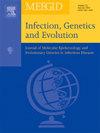Genetic variation and population structure of Taenia multiceps (Coenurus cerebralis) based on mitochondrial cox1 gene: A comprehensive global analysis
IF 2.6
4区 医学
Q3 INFECTIOUS DISEASES
引用次数: 0
Abstract
Taenia multiceps is a neglected parasite having veterinary and public health importance. The predilection sites of the parasite larva (Coenurus cerebralis) are brain (cerebral coenurosis) and subcutaneous (non-cerebral coenurosis). There is a dearth of data regarding molecular characterization of T. multiceps and even fewer population structure-based studies on T. multiceps. The current study was conducted to provide epidemiological information regarding the global population structure of the parasite. The NCBI GenBank database was accessed to download the sequences of cox1 gene, which were further subjected to PopArt software to construct median-joining networks. The DnaSp software was used to compute neutrality and diversity indices. Host and region-wise indices of neutrality and diversity were also computed. There were 166 gene sequences found in the NCBI database. Followed by removal of short gene sequences, 143 were considered to perform bioinformatic analyses. A total of 30 haplotypes with 46 mutations and 23 parsimony informative sites were found. High diversity (Hd = 0.889, π = 0.01186) and negative but statistically insignificant neutrality indices (Tajima's D = −1.57659, Fu's Fs = −10.552) were found. Region-wise results revealed highest haplotype diversities in isolates from KSA (Hd = 1.00) followed by Greece and Italy (Hd = 0.962), and China (Hd = 0.931). Host-wise data analysis showed an overall negative Tajima's D value and there exists highest haplotype diversity in cattle (Hd = 1.00) followed by dogs (Hd = 0.833), sheep (Hd = 0.795) and goats (Hd = 0.788). The findings of the study indicate that the population diversity of T. multiceps will increase worldwide as shown by high diversity and negative neutrality indices. The findings of the study significantly add-in to the existing bank of knowledge about population structure of T. multiceps. We recommend conducting more studies employing different genetic markers to better comprehend the epidemiology of the parasite.
基于线粒体 cox1 基因的多尾藻类(Coenurus cerebralis)遗传变异和种群结构:全球综合分析。
多尾疟原虫是一种被忽视的寄生虫,对兽医和公共卫生具有重要意义。寄生幼虫(Coenurus cerebralis)的寄生部位是脑(脑同形虫)和皮下(非脑同形虫)。有关多尾栉水母的分子特征的数据十分匮乏,基于种群结构的多尾栉水母研究更是少之又少。本研究旨在提供有关该寄生虫全球种群结构的流行病学信息。研究人员从 NCBI GenBank 数据库中下载了 cox1 基因的序列,并用 PopArt 软件构建了中位连接网络。DnaSp 软件用于计算中性指数和多样性指数。同时还计算了宿主和区域的中性指数和多样性指数。在 NCBI 数据库中发现了 166 个基因序列。在剔除短基因序列后,有 143 个基因序列被考虑用于生物信息学分析。共发现 30 个单倍型,46 个突变和 23 个解析信息位点。发现了高多样性(Hd = 0.889,π = 0.01186)和负中性指数(Tajima's D = -1.57659,Fu's Fs = -10.552),但在统计上并不显著。按地区划分的结果显示,来自叙利亚的分离物的单倍型多样性最高(Hd = 1.00),其次是希腊和意大利(Hd = 0.962)以及中国(Hd = 0.931)。宿主方面的数据分析显示,Tajima's D 值总体呈负值,牛的单倍型多样性最高(Hd = 1.00),其次是狗(Hd = 0.833)、绵羊(Hd = 0.795)和山羊(Hd = 0.788)。研究结果表明,从高多样性和负中性指数可以看出,多角体T. multiceps的种群多样性将在全球范围内增加。研究结果极大地丰富了现有的多裂蹄铁种群结构知识库。我们建议利用不同的遗传标记开展更多研究,以更好地了解寄生虫的流行病学。
本文章由计算机程序翻译,如有差异,请以英文原文为准。
求助全文
约1分钟内获得全文
求助全文
来源期刊

Infection Genetics and Evolution
医学-传染病学
CiteScore
8.40
自引率
0.00%
发文量
215
审稿时长
82 days
期刊介绍:
(aka Journal of Molecular Epidemiology and Evolutionary Genetics of Infectious Diseases -- MEEGID)
Infectious diseases constitute one of the main challenges to medical science in the coming century. The impressive development of molecular megatechnologies and of bioinformatics have greatly increased our knowledge of the evolution, transmission and pathogenicity of infectious diseases. Research has shown that host susceptibility to many infectious diseases has a genetic basis. Furthermore, much is now known on the molecular epidemiology, evolution and virulence of pathogenic agents, as well as their resistance to drugs, vaccines, and antibiotics. Equally, research on the genetics of disease vectors has greatly improved our understanding of their systematics, has increased our capacity to identify target populations for control or intervention, and has provided detailed information on the mechanisms of insecticide resistance.
However, the genetics and evolutionary biology of hosts, pathogens and vectors have tended to develop as three separate fields of research. This artificial compartmentalisation is of concern due to our growing appreciation of the strong co-evolutionary interactions among hosts, pathogens and vectors.
Infection, Genetics and Evolution and its companion congress [MEEGID](http://www.meegidconference.com/) (for Molecular Epidemiology and Evolutionary Genetics of Infectious Diseases) are the main forum acting for the cross-fertilization between evolutionary science and biomedical research on infectious diseases.
Infection, Genetics and Evolution is the only journal that welcomes articles dealing with the genetics and evolutionary biology of hosts, pathogens and vectors, and coevolution processes among them in relation to infection and disease manifestation. All infectious models enter the scope of the journal, including pathogens of humans, animals and plants, either parasites, fungi, bacteria, viruses or prions. The journal welcomes articles dealing with genetics, population genetics, genomics, postgenomics, gene expression, evolutionary biology, population dynamics, mathematical modeling and bioinformatics. We also provide many author benefits, such as free PDFs, a liberal copyright policy, special discounts on Elsevier publications and much more. Please click here for more information on our author services .
 求助内容:
求助内容: 应助结果提醒方式:
应助结果提醒方式:


